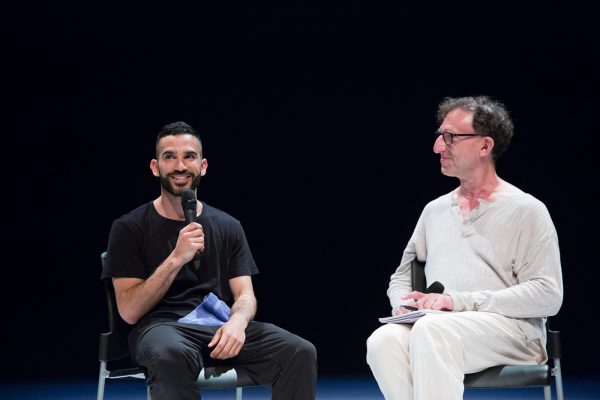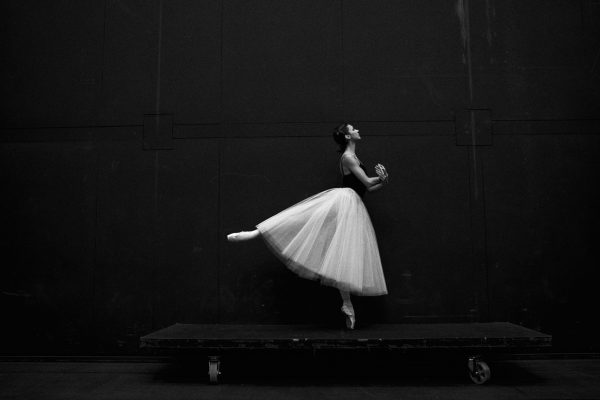Shawn Hounsell takes the unknown by the horns — an approach that describes how he first got into dance. The choreographer for the new CBC digital comedy Off Kilter first intended to study computer science at university, but he ended up “a ballerina instead,” as he describes. He began his life in dance at the Royal Winnipeg Ballet School when he was seventeen. “I was discovering the relationship with my physical self,” he explains. “How I perceived the world as an adolescent was largely from an intellectual bent, and the chance to discover and express myself with my body, I think, was this big revelation.”
Through his revelation, Hounsell crossed a boundary, and he’s been doing it ever since. There are the obvious trespasses in his CV: moving from Canada’s Royal Winnipeg Ballet (RWB) to Les Grands Ballets Canadiens in 1995, for example, and hanging up his dance shoes in 2007. But he’s also part of the wave that is changing dance by blurring boundaries. Whether using multimedia and voice-overs in ballet or crossing dance genres, Hounsell doesn’t focus on any kind of genre or style. “I really enjoy feeding on what’s put in front of me,” he says. “So, that can be a contemporary dancer, a flamenco dancer, a hip hop artist. Quite often the creative process is, for me, the results of the energies that are in the room.”
I remember dance in the eighties, when I was full into the competition circuit. In my mind, differentiating dance styles came down to the shoes: tap, jazz and ballet all had different shoes, and modern had none. Sure, you had your gimmicks, like pointe shoes with taps on them, but anecdotally, I’d say ninety-nine per cent of the dance styles I was exposed to could be deduced by the shoe.
It didn’t take long, though, for jazz sneakers to be used for more than jazz. And remember split-sole tap shoes? Not only could you point your feet, but you could stand en pointe too. (Though fouetté turns were out.) Amateur wrestling boots even had a short-lived craze as a great jazz shoe and, thanks to Tap Dogs, Blundstones could become tap shoes.
The shoes were only the beginning, though, and signalled what was coming.
“I think now in dance there’s a lot more crossover than there was years ago,” Hounsell explains. “Things were very compartmentalized. I think now, especially in any classical ballet company, the dancers have the ability to express themselves in a vast number of languages.”
Boundaries in dance are blurring everywhere, even in the studio where dancers now often have more input into the pieces they’re dancing in than they did in the past. And Hounsell fully embraces this: “I think more so now than perhaps thirty years ago, the dancers also are integrated into the creative process through improvisation, casting, so that it’s a lot less ‘here’s the steps, here’s the counts.’ The creative process now is a much broader field of exploration,” he says.
In addition to all the work he’s done for stage thus far, Hounsell has also choreographed for screen, his most recent production being Off Kilter, the comedic mockumentary by Alejandro Álvarez Cadilla. It’s easy to fall into the pool of slapstick choreography when working in a comedy, but for this show, Hounsell was asked to create beautiful dance sequences that exist within a comedic world.
Off Kilter follows fictional choreographer Milton Frank as he tries to make a comeback after a plagiarism scandal in the nineties. The neurotic creator choreographs a short piece with two dancers, Anna and Luke, played by retired dancer Sarah Murphy-Dyson and National Ballet of Canada dancer Brendan Saye. Along the way, he faces roadblocks, like unequal pay for female dancers, unannounced rehearsal interruptions, hidden injuries, his own inner demons and more.
And yes, you do get to laugh at all of that. “What’s brilliant about the show is it humanizes that place [the ballet world] while also showing the craft and commitment and beauty of classical dance,” Hounsell says. “Even the characters — Milton, and the gentleman who owns the building, and the dancers. I think it’s wonderful because it puts the human face onto an exotic world.”
This isn’t Hounsell’s first comedic venture. “It’s something I’m quite attracted to. As a dancer, and as a choreographer, I’ve always enjoyed humour onstage,” he says. (He received a shout-out in The New York Times for his comedic performance as a waiter in the RWB’s production of Balanchine’s Allegro Brillante back in 1992.)
Hounsell got involved in Off Kilter because he and Álvarez Cadilla had danced together in the past, and Hounsell describes them as very close personal friends. They had worked together on an earlier concept about ten years ago, and the version that made it to CBC is a reworking of Álvarez Cadilla’s earlier idea.
Off Kilter is about a dance piece that will be performed in front of a live audience, theatre-style, but requires Hounsell to choreograph for the camera. “If you’re creating a structure for stage,” Hounsell says, “there’s an arc or a through-line, and when you’re working in TV or film, it’s less beginning-middle-end and more vignette-ish.”
For example, a screen choreographer may be requested to create something that is a minute long, has four people and will be shot from above. The camera also offers visual flexibility that a stage does not because a theatre audience will have a fixed perspective, whereas the camera will move around the dancers, offering viewers an omnidirectional perspective. In other words, the camera has offered Hounsell a new way to explore his world of dance, just like his discovery of ballet did several decades ago.
The future of Off Kilter is still undecided: “We’re waiting to see where it goes and how things play out. But certainly, for my part, I’d be more than happy to continue working on this,” Hounsell says. He’s also in the early stages of several other projects right now, though nothing he can be too specific about at this time.
Whatever his future holds, Hounsell will keep exploring the energies placed in front of him, riding the wave of dance that is blurring boundaries and exposing audiences to new perspectives.





